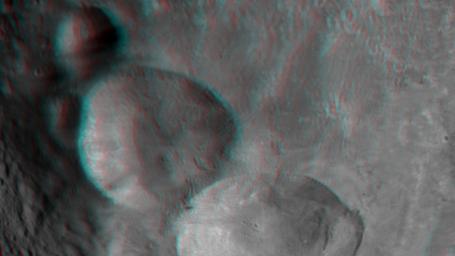3-D Image of Vesta’s “Snowman” Craters
Caption:
This 3-D image, called an anaglyph, shows the topography of Vesta's "Snowman" craters. To create this anaglyph two differently colored images are superimposed with an offset to create depth. When viewed through red-blue glasses, this anaglyph shows a 3-D view of Vesta's surface. The images used to generate the two differently colored images that make up this anaglyph were obtained during Dawn's mission in August 2011. At the time the distance from Dawn to Vesta was about 2,700 kilometers (1,700 miles), which results in an image resolution of about 250 meters (820 feet) per pixel. The depth effect or topography differences in this anaglyph were calculated from the shape model of Vesta. North points to the left in this anaglyph. The three "snowman" craters dominate this image: the bottom crater, which is about 63 kilometers (40 miles) in diameter on average, has been named Marcia; the middle crater, which is about 53 kilometers (33 miles) in diameter on average, has been named Calpurnia and the top crater, which is about 24 kilometers (15 miles) in diameter on average, has been named Minucia. It is likely that Marcia and Calpurnia formed from the impact of a binary asteroid and that Minucia formed in a later impact. The region surrounding the three craters is relatively smooth because this is the ejecta blanket of the craters. A number of slumping features are clearly seen in both Marcia and Calpurnia.
Background Info:
The Dawn mission to Vesta and Ceres is managed by NASA's Jet Propulsion Laboratory, a division of the California Institute of Technology in Pasadena, for NASA's Science Mission Directorate, Washington. UCLA is responsible for overall Dawn mission science. The Dawn framing cameras have been developed and built under the leadership of the Max Planck Institute for Solar System Research, Katlenburg-Lindau, Germany, with significant contributions by DLR German Aerospace Center, Institute of Planetary Research, Berlin, and in coordination with the Institute of Computer and Communication Network Engineering, Braunschweig. The framing camera project is funded by the Max Planck Society, DLR, and NASA/JPL.
More information about the Dawn mission is online at
http://www.nasa.gov/dawn
and
http://dawn.jpl.nasa.gov
.
Cataloging Keywords:
| Name |
Value |
Additional Values |
| Target |
4 Vesta |
|
| System |
Main Belt |
|
| Target Type |
Asteroid |
|
| Mission |
Dawn |
|
| Instrument Host |
Dawn |
|
| Host Type |
Orbiter |
|
| Instrument |
Framing Camera (FC) |
|
| Detector |
|
|
| Extra Keywords |
Binary, Color, Crater, Impact |
| Acquisition Date |
|
| Release Date |
2012-01-24 |
| Date in Caption |
|
|
| Image Credit |
NASA/JPL-Caltech/UCLA/MPS/DLR/IDA |
| Source |
photojournal.jpl.nasa.gov/catalog/PIA15321 |
| Identifier |
PIA15321 |

 Planetary Data System
Planetary Data System
